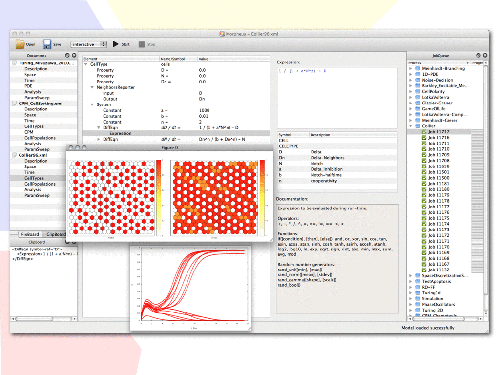Morpheus
Morpheus is a modeling and simulation environment for the study of multiscale and multicellular systems.
Morpheus is being developed by Jörn Starruß, Walter de Back and Lutz Brusch at the IMC group headed by Prof. Andreas Deutsch. We are part of the Center for High Performance Computing and the Institute for Medical Informatics and Biometry at the TU Dresden, Germany.
| Website moved – Jan 2019 | |
|---|---|
 We moved our website to a new location. We moved our website to a new location. Most information here is still valid, but for current releases, blogs and tutorials read https://morpheus.gitlab.io |
Modeling multicellular systems
Morpheus implements algorithms and solvers for the simulation and integration of cell-based (Potts) models, reaction-diffusion systems and models of ordinary differential equations. Due to its modular design, it allows a range of auxiliary spatiotemporal models to be constructed.
Check out the example models for an overview of modeling possibilities. For details, see the user manual.
Modeling without programming
Morpheus uses a model description language based on biological and mathematical terminology to translate model descriptions into numerical simulations. This domain-specific language allows the construction of complex multiscale models without programming or scripting.
It enables the straight-forward specification of mathematical models, such as systems of differential equations, in conventional in-fix notation, parsed by muparser.
Automated model integration
Integration of models representing processes at multiple spatiotemporal scales is, to a large extent, automated in Morpheus. Based on the inter-dependencies between (sub)models as specified in mathematical expressions, the simulator automatically maps spatial data and schedules of numerical updates such that ensure validity and optimize computational performance.
Graphical user interface
The stand-alone graphical user interface provides a number of workflow tools. Its features include:
- A model editor to create and edit models
- Job control to execute multithreaded and parallel simulations
- A result archive to browse simulation results and restore models
- Batch processing for parameter exploration and sensitivity analysis
- Execution of simulations on remote high performance computers
Publications
Check out the list of publications for papers on Morpheus or its application in research and education.
Μορφευς is the Greek god of dreams. The name signifies the fashioner or moulder, because he shaped or formed the dreams which appeared to the sleeper. (Ovid's Metamorphoses xi. 635., Smith, 1873).



